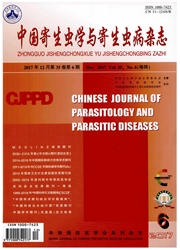

 中文摘要:
中文摘要:
目的研究3种不同易感性宿主感染日本血吸虫后免疫应答特征的差异,初步探讨适宜和非适宜鼠类宿主感染血吸虫后免疫应答的机制。方法C57BL/6小鼠、Sprague Dawley(SD)大鼠和东方田鼠(Microtus fortis)各12只,均随机分为感染组和未感染组.每组6只。C578146小鼠、SD大鼠和东方田鼠的感染组每鼠经腹部皮肤分别感染日本血吸虫尾蚴20、200和1000条。感染后42d,剖杀各组动物。观察门脉系统成虫寄生及肝脏肉芽肿情况。收集血清,EUSA法检测细胞因子白细胞介素10(IL-10)、1干扰素(IFN-γ)和血清特异性抗体IgG、IgG2a.及IgG,的水平。结果感染日本血吸虫后42d,C57BL/6小鼠和SD大鼠均检获日本血吸虫成虫,并在宿主肝脏发现虫卵肉芽肿,而东方田鼠未检获血吸虫成虫及虫卵,肝脏正常。SD大鼠血清中IL-10的含量[(2.21±0.12)pg/ml]明显高于东方田鼠[(1.64±39)pg/ml](P〈0.05)和C57BI/6小鼠[(0.10±0.04)pg/ml)](P〈0.01),而东方田鼠也显著高于C57BIJ6小鼠(P〈0.01);SD大鼠血清中IFN-γ/的含量[(0.21±0.11)pg/ml]均高于东方田鼠[(0.11±0.03)pg/ml]和C57BL/6小鼠[(0.09±0.02)pg/ml](P〈0.05),而C57BL/6小鼠与东方田鼠组间差异无统计学意义(P〉0.05);SD大鼠IgG(1.53±0.31)、IgG1(1.48±0.44)、IgG2a(0.41±0.11)水平均显著高于东方田鼠各抗体亚类水平(0.48±0.14、0.15±0.03和0.12±0.06)(P〈0.01),C57BL/6小鼠IgG(1.21±0.16)和IgG1(0.88±0.31)水平也显著高于东方田鼠(P〈0.01),3种鼠血清抗体亚类均以IgG,占优势。未感染组C57BL/6小鼠、SD大鼠及东方田鼠均未检测出IL-10、IFN-γ及抗体亚类IgG、IsG1、IgG2α的表达。结论与Th2型免疫应答主要相关的细胞因子IL-10在血吸虫非适宜宿主体内水平显著高于适宜宿主?
 英文摘要:
英文摘要:
Objective To study the difference among immune responses of three kinds of experimental animals with different susceptibility to the infection of Schistosoma japonicum, and preliminarily explore the mechanism of the immune response in permissive and non-permissive hosts. Methods Twelve animals of each kind of rodents, C57BL/6 mice, Sprague Dawley (SD) rats and Microtus fortis, were randomly divided into the infected group and uninfected group each with 6 animals. In infected groups of C57BL/6 mice, SD rats, and M. fortis, each animal was infected with 20, 200 and 1 000 cercarie of S. japonicuml respectively. 42 d later, all rodents were sacrificed. Adult worms in portal vein and granulomas in liver were observed and the sera were collected. The levels of cytokines IL-10 and IFN-γ as well as serum IgG, IgG2,, and IgG1 were detected by ELISA . Results At the 42th day post infection, worms in portal vein and liver granulomas were observed in C57BIJ6 mice and SD rats, but not in M. fortis. The level of IL-10 in the sera of SD rats [(221±0.12) pg/ml] was significantly higher than that in the sera of M. fortis [(1.64±0.39) pg/ml] and C57BU6 mice [(0.10-±0.04) pg/ml] (P〈0.01). IL-10 in the sera of M. fortis was also significantly higher than that in the sera of C57BU6 mice (P〈0.01). IFNq in the sera of SD rats [(0.21±0.11)pg/ml] was significantly higher than that in the sera of M. fortis [(0.11±0.03) pg/ml] and C57BL/6 mice [(0.09±0.02) pg/ml] (P〈0.05), but no difference between M. fortis and C57BL/6 mice (P〉0.05). The levels of IgG(153±0.31), IGG1(1.48±0.44) and IgG2a(0.41±0.11) in SD rats were significantly higher than that in the sera of M. fortis (0.48±0.14, 0.15±0.03 and 0.12±0.061) (P〈0.01). The levels of IgG (1.21±0.16), IgG1 (0.88±0.31) in C57BIJ6 mice were significantly higher than that in the sera of M. fortis (P〈0.01). IgG1 antibody is the predominant subclass in the three kinds of rodents. The levels of IL-
 同期刊论文项目
同期刊论文项目
 同项目期刊论文
同项目期刊论文
 Deposited eggs of Schistosoma japonicum in spleen : pathogen that induces apoptosis of splenic T cel
Deposited eggs of Schistosoma japonicum in spleen : pathogen that induces apoptosis of splenic T cel 期刊信息
期刊信息
